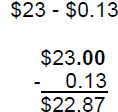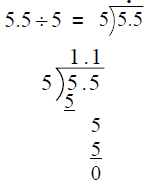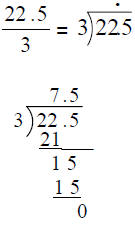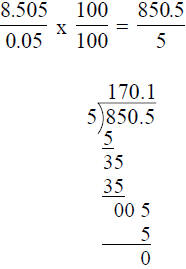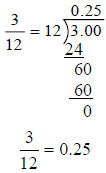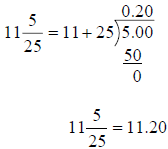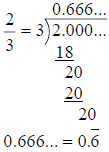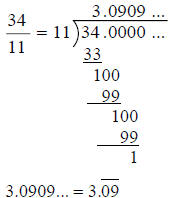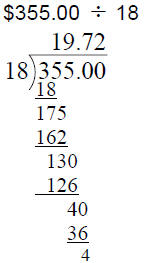DECIMAL COMPETENCY PACKET
In this booklet arithmetic operations involving decimal
numbers are
explained . If you have not already reviewed the Fraction booklet,
please do so before working through this one.
Calculators are not allowed when taking the Computerized
Placement Test (CPT), nor in Fundamentals of Mathematics, Pre-
Algebra, and Elementary Algebra; therefore, do not rely on a calculator
when working the problems in this booklet.
To use this booklet, review the glossary, study the examples, then
work through the exercises, and check your answers at the end of the
booklet. When you find an unfamiliar word, check the glossary for a
definition or explanation. The last several pages are Place Value
Charts that will be helpful to you. Remove those pages for easier use.
If you have difficulty understanding any of the concepts, come to
one of the Tutoring Centers located on the Lynn, Danvers Main and
Danvers Hathorne Campuses. Hours are available at (978) 762-4000 x
5410.
The Centers are closed when school is not in session, and
Summer hours are limited.
Table of Contents
| Glossary | 5 |
| General Decimal Information | 6 |
| Place Value | 7 |
| Writing and Reading Decimals | 8 |
| Translating Numerical Expressions | 9 |
| Decimal Fractions | 10 |
| Comparing Decimals | 11 |
| Rounding | 12 |
| Addition | 14 |
| Subtraction | 15 |
| Multiplication | 16 |
| Multiplication by Multiples of 10 | 17 |
| Division by Multiples of 10 | 18 |
| Division by Whole Numbers | 19 |
| Division by Decimals | 20 |
| Converting Fractions to Terminating Decimals | 21 |
| Converting Fractions to Repeating Decimals | 22 |
| Converting Decimals to Fractions | 23 |
| Decimal Word problems | 24 |
| Answers | 27 |
| Place Value Charts | 30 |
Glossary
| Decimal or Decimal Number |
Any number that includes place value to the right of a decimal point. |
| Decimal Point | A dot or point that separates the decimal value from the integral value of a number. |
| Denominator | The bottom number of a fraction. It represents
the number of pieces needed to make one whole. (See Fraction booklet for more information.) |
| Difference | The result when two numbers are subtracted. The order of subtraction is important . A – B means that the number represented by B is subtracted from A, that is A is the “top number” in a vertical subtraction. |
| Digit | The symbols 0, 1, 2, 3, 4, 5, 6, 7, 8, 9 are the
digits of the Base ten number system. |
| Division | Arithmetic operation: Dividend ÷ Divisor = Quotient Expressed as a fraction:  or using a "division house"  |
| Factor | Each of the numbers that are multiplied, i.e. in
the product 7 x 9=63 the numbers 7 and 9 are factors. |
| Multiple | A number which is the product of a given number and another factor; Multiples are equal to or larger than the given number, i.e. the multiples of 3 are: 3,6,9,12,15, … |
| Non-Repeating Decimal |
A decimal representation that has no pattern of repetition in the digits after the decimal point. |
| Numerator | The top number of a fraction. It represents the number of pieces of a certain size considered for the expression . (See fraction booklet for more information) |
| Place Value | The position a digit holds in a number. It tells
us the value of the digit. (See chart page 7) |
| Product | The result when two numbers are multiplied. |
| Quotient | The result when two numbers are divided. |
| Repeating Decimal |
A numerical representation that has a pattern of
digits that repeats to infinity. 0.323232… is a repeating decimal, and can be written as  |
| Sum | The result when two numbers are added. |
| Terminating Decimal |
Every fraction can be written as a decimal by
dividing the denominator into the numerator if there no remainder, the decimal will terminate. |
| Whole Numbers | Positive numbers with no fractional or decimal portion. |
General Decimal Information
♦ Our number system is a decimal system using the digits: 0, 1, 2, 3, 4, 5,
6, 7, 8, and 9, called the Base Ten Number System.
♦ Only positive numbers will be used in this booklet.
♦ Whole numbers are decimal numbers with no fractional part; a decimal
point is assumed to be to the right of the whole number. ( i.e., 15 = 15.0)
♦ Numbers with no whole number component will be written with a zero
preceding the decimal point. ( i.e., 0.23)
♦ Digits to the right of a decimal point represent fractional parts with a
denominator of a multiple of ten.
♦ Digits to the left of the decimal point are separated into groups of three
using commas.
Place Value
The position of a digit in a number reflects the "place value" of that digit. In
the following table, the number represented has value according to the place
the digit "1" holds in each case. (Note the use of commas.)
In the following chart, note the similarity of place value names on both sides
of the decimal. Those places to the right of the decimal end in "ths"
indicating that they are fractional.
| Whole Numbers | Decimal Fractions | ||||||||||||||||
 |
 |
||||||||||||||||
| Etc. | Ten Millions | Millions, | Hundred Thousands | Ten Thousands | Thousands, | Hundreds | Tens | Units (Ones) | Decimal Point (and) | Tenths | Hundredths | Thousandths | Ten-Thousandths | Hundred-Thousandths | Millionths | Ten Millionths | Etc. |
| 1 | 0 | 0 | 0 | 0 | 0 | 0 | • | 0 | 0 | 0 | 0 | 0 | 1 | ||||
| 1 | 0 | 0 | 0 | 0 | 0 | • | 0 | 0 | 0 | 0 | 1 | ||||||
| 1 | 0 | 0 | 0 | 0 | • | 0 | 0 | 0 | 1 | ||||||||
| 1 | 0 | 0 | 0 | • | 0 | 0 | 1 | ||||||||||
| 1 | 0 | 0 | • | 0 | 1 | ||||||||||||
| 1 | 0 | • | 1 | ||||||||||||||
| 1 | • | 0 | |||||||||||||||
| 0 | • | 1 | |||||||||||||||
In a spoken or written number, the word "and"
reflects placement of a
decimal point. Although each number uses the same digits, (ones and
zeros), the value of each number in the chart above is very different. The
numbers, in order of the chart, are read:
one million and one millionth
one hundred thousand and one hundred-thousandth
ten thousand and one ten-thousandth
one thousand and one thousandth
one hundred and one hundredth
ten and one tenth
one and no tenths, or more commonly, one
one tenth
Writing Decimals
| Place value is reflected when writing
and reading decimal numbers in words. In writing the decimal is represented by the word "and." |
||
| Example: | ||
| 4.7 | is written | "four and seven tenths." |
| 70.024 | is written | "seventy and twenty-four thousandths." |
Write the following in words as you would write the
number. (Use the
chart at the end of the booklet to aid with number placement.)
1) 20.15
2) 45.21
3) 15.196
4) 2,049.009
5) 0.005
6) 4.05
7) 278.54
8) 7.0007
9) 1.1
10) 1928.07
Translating Numerical Expressions
| To translate written numerical
expressions, place the last written number in the correct place value. |
|
| Example: Twenty and ninety six thousandths 20.096 20.096 |
Six, (6) the last digit belongs in the
thousandths place. (Third place to the right from the decimal point.) Zero must be entered in the tenths place. |
Write the following using digits. (Use a chart if
needed)
1) four and five tenths
2) fourteen hundredths
3) one thousand nine hundred seventy-two ten thousandths
4) four hundred seven and three hundred twenty-eight thousandths
5) one tenth
6) seven and nine hundredths
7) one hundred seventy-two ten-thousandths
8) twenty-two and five tenths
9) twenty and four hundred ninety-six thousandths
10) three hundred and three hundredths
Decimal Fractions
| A decimal number is another way to
write a fraction with a denominator of a multiple of ten, (i.e., denominators equal to 10; 100; 1,000; 10,000; etc.) To convert a fraction with a denominator of a multiple of ten to a decimal, read the fraction and write as a decimal number. |
|
| Example:
Example:
Example:
|
is read " three and seven tenths" expressed with digits is read " fifteen and two hundred thirty-four thousandths" expressed with digits is read " five hundredths" expressed with digits. Note the zero placement. |
Write as a decimal number.
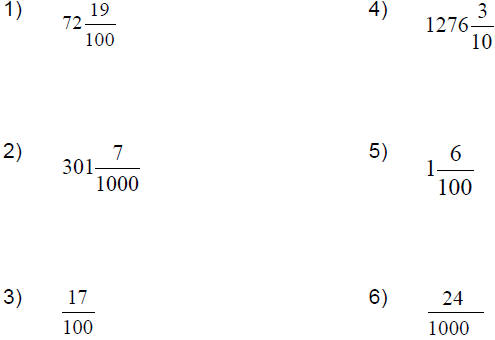
Comparing Decimals
| To compare decimals, write the
decimal numbers with the same number of decimal places and decide which is larger. |
|
| Example: Which is greater: 0.9 or 0.91? 0.90 ? 0.91 Example: Write the following from smallest to largest: 0.78006, 0.7845, 0.7851, 0.785, 0.78 0.78006, 0.78450, 0.78510, 0.78500, 0.78000 0.78000, 0.78006, 0.78450, 0.78500, 0.78510 |
To compare write both numbers with two decimal places. Note zeros may be added or deleted from the right and after the decimal point. Compare digits in hundredths place. 1 is greater than 0; therefore, 0.91 is greater. (hint: Consider money) Write the list adding zeros to hundred thousandths place as needed. Since the digits in the tenths and hundredths places are the same, compare the digits in the thousandths place first. Then compare the digits in the remaining places. Re-write the list from smallest to largest. |
Write from smallest to largest:
1) 12.34, 1.234, 0.1234
2) 0.1, 0.01, 1.001
3) 3.1, 0.031, 0.331
4) 0.06, 0.4, 0.9
5) 0.935, 1.2, 0.6, 0.56
6) 0.12, 0.16, 0.2, 0.48, 0.054
7) 5.038, 5.0382, 50.382, 0.5382
8) 0.08, 8.08, 8.808, 8.888, 0.088, 0.8
Rounding
| To round numbers for estimation: 1. Identify the place value to be rounded. All digits to the left of that place remain the same. 2. Check the number to the immediate right of the place to be rounded: a. If the digit in that place is 5 or greater, add one to the digit in the place to be rounded. OR b. If the digit in that place is 4 or less, do not change the digit in the place to be rounded. 3. Fill in the remaining place values to the right of the place to be rounded with zeros, or drop the digits after the decimal point. |
|
| Example: Round 1792 to the hundreds place. 18 _ _ 18 0 0 Example: Round 73.64 to the tenths place. 73.6 _ 73.60 = 73.6 Example: Round 49.897 to the hundredths place. 49. 8 10 _ 49.(8+1) 0 _ 49.90 |
Identify the place value to be rounded, (7
hundred). Write the digit(s) to the left (1). Identify the number to the right (9). 9 is greater than 5; add one to 7, (7+1=8), enter 8 in the hundreds place. Fill in all the places to the right with zeros. Identify the place value to be rounded, (6 tenths). Write the digits to the left (73). Identify the number to the right (4). 4 is less than 5, 6 remains in the tenths place. It is not need to fill in all the places to the right with zeros; rounding to tenths place. Identify the place value to be rounded, (9 hundredths). Write the digits to the left (49.8). Identify the number to the right, (7). 7 is greater than 5, add one to 9. Since 9 + 1 = 10, a zero is entered in the hundredths place, and the 1 is carried to the tenths place. The 1 is added to 8. The zero is needed to represent the hundredths place. |
Round these numbers as indicated.
1)Tenths 62.87
2) Units 14.45
3) Ten thousandths 3.56906
4) Tenths 3.1416
5) Hundreds 459.326
6) Tenths 19.77
7) Thousandths 0.0067
8) Tens 389.88
9) Units 33.97
10) Hundredths 49.995
11) Thousandths 5.0074
12) Thousandths 0.6739
13) Tenths 1.98
14) Ten thousandths 0.01704
15) Hundredths 0.01011
16) Thousandths 0.0007
Addition
| To add decimals, write the numbers
vertically with the decimal points directly under each other, then add the digits. Note: When the decimal points are lined up , the digits are automatically lined up in the correct place value. |
|
| Example: 13.2 + 1.57
Example:
|
Write the problem vertically. Line up the decimal points. Note the additional zero. Adding zeros to the right of the final digit after the decimal does not change the value of the number. Dollar values are the most familiar decimal values. Write the problem vertically. Line up the decimal points. The additional zeros are optional, but help with placement. Note dollar sign use. |
Find the Sum (Add):
1) 0.03 + 0.4
2) 0.3 + 0.03 + 0.003
3) 2.05 + 0.561 + 43.9 + 17.32
4) $4 + $14.01
5) 8.0632 + 0.234 + 0.81 + 0.064
6) 48 + 0.84
7) 10 + 9.6 + 3.76 + 8.451
8) $3.06 + $2.13 + $4.89
9) 2,134.07 + 306.5 + 2.109
10) 56.3701 + 0.268 + 4.2
Subtraction
| To subtract decimals, write the
numbers vertically with decimal points directly under each other, and add zeros when needed, then subtract the digits. Note: When the decimal points are lined up, the digits are automatically lined up in the correct place value. |
|
| Example:
Example:
|
Write the problem vertically. Line up the
decimals. Remember: always write the first number on the top. Add zeros to the number with fewer places to the right of the decimal point. Subtract. Write the problem vertically. Line up the decimals. Insert the decimal point and two zeros. Subtract; borrow if necessary. |
Find the Difference (Subtract):
1) 8.4 - 7.35
2) 12.5 - 8.7
3) $17.50 - $6.25
4) $18 - $5.63
5) 4.355 - 1.647
6) 60.54 - 0.928
7) 89. - 58.46
8) 104.003 - 21.78
Find the Sum and Difference as indicated, (in the order
indicated):
9) 14.6 - 1.98 + 3.7
10) 5.67 + 0.34 - 2.05
11) 0.19 + 2.34 - 1.003
12) $21.90 - $0.45 - $ 2.34
Multiplication
| To multiply decimals, write the
problem and multiply as you would a whole number multiplication problem. The product (answer) of two decimal numbers has the same number of decimal places after the decimal point as the total number of decimal places in the two numbers being multiplied. |
|
| Example: 0.19 x 0.4
Example:
|
Write vertically. (The decimal points do not have
to line up.) 2 decimal places (Decimal points not lined up.)  Count from right to left; add a zero before the decimal point. 0 decimal places (Decimal points not lined up.)  Count from right to left to place decimal point. |
Find the Product (multiply):
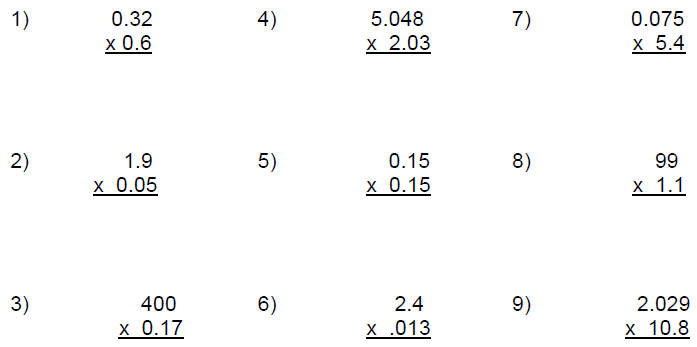
Multiplication by Multiples of 10
| To multiply by a multiple of ten,
move the decimal point RIGHT as many places as there are zeros in the multiplier. |
|
| Example:
Example:
Example:
|
There is one zero in the multiplier (10);
therefore, the decimal point moves right one place. There are three zeros in the multiplier (1000); therefore, the decimal point movers right three places. There are two zeros in the multiplier, (100); therefore, the decimal point moves right two places. Note the additional zeros. |
Multiply:
1) 4.83 x 10 =
2) 83.5 x 1000 =
3) 90.2 x 100 =
4) 10.37 x 10 =
5) 0.76 x 1000 =
6) 0.08 x 10 =
7) 35.961 x 100 =
8) 82.6 x 1000 =
9) 7.007 x 100 =
10) 72.953 x 10 =
11) 0.987 x 1000 =
12) 476.098 x 10,000 =
Division by Multiples of 10
| To divide by a multiple of ten, (10;
100; 1,000; etc.), move the decimal point to the LEFT as many places as there are zeros in the divisor. |
|
| Example:
Example:
|
There is one zero in the divisor (10),
therefore the decimal point moves left one place. There are three zeros in the divisor (1000), therefore the decimal point moves left three places. Note the additional zeros. |
Divide:
1) 82.5 ÷ 100 =
2) 923.8 ÷ 1000 =
3) 0.754 ÷ 10 =
4) 0.845 ÷ 100 =
5) 63.8 ÷ 100 =
6) 78.567 ÷ 10 =
7) 54.87 ÷ 1000 =
8) 20.35 ÷ 10 =
9) 540.8 ÷ 100 =
10) 6200 ÷ 10,000 =
Division by Whole Numbers
| To divide a decimal by a whole
number, place the decimal point in the quotient directly above the decimal point in the dividend to ensure the correct place value. Divide as with whole numbers. |
|
| Example:
Example:
|
Write the problem with a "division house,"
placing the quotient's (answer's) decimal point directly over the decimal point of the dividend. A fraction is another way to express a division problem. The divisor is the denominator and the dividend is the numerator. Write the problem with a "division house," placing the quotient's (answer's) decimal point directly over the decimal point of the dividend. |
Divide:
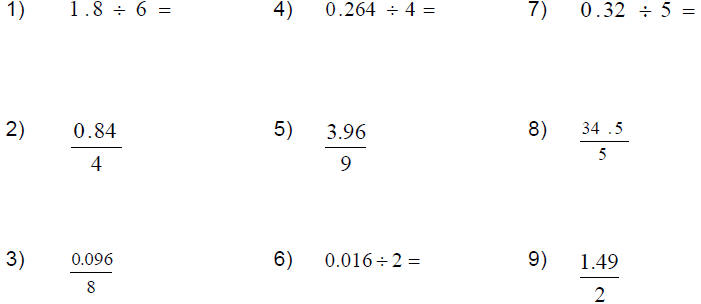
Division by Decimals
| In division, the divisor must be a
whole number. To convert a decimal divisor to a whole number, multiply the divisor and the dividend by a multiple of ten. Then divide as usual. |
|
| Example:
Example:
|
The divisor (0.7) has one decimal place.
To change the divisor to a whole number, multiply the divisor and the dividend by 10. Divide as usual. The divisor (0.05) has two decimal places. To change the divisor to a whole number, multiply the divisor and the dividend by 100. Divide as usual. Place the decimal point for the quotient (170.1) directly above the decimal point in the dividend (850.5) |
Divide:
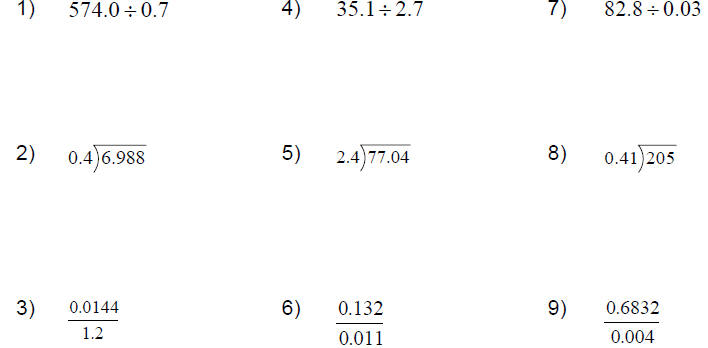
Converting Fractions to Terminating Decimals
| To convert a fraction to a decimal,
divide. Some fractions will convert to a decimal representation with a remainder of zero, called a terminating decimal. |
|
| Example: Convert to a Decimal
Example:
|
Divide 3 by 12. The decimal equivalent to three twelfths is twenty-five hundredths. The whole number portion of the number will remain the same. The fraction will convert to a decimal. Divide 5 by 25. The decimal equivalent to eleven and five twenty-fifths is eleven and two tenths. |
Convert to a Decimal:
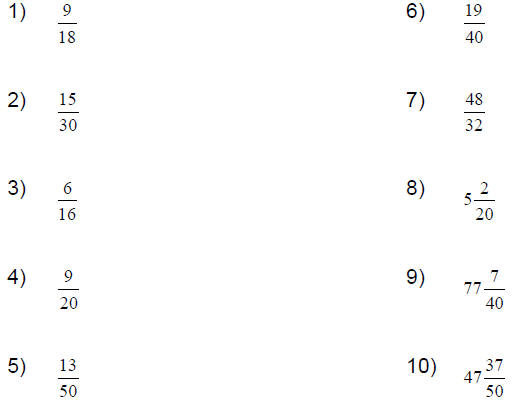
Converting to Repeating Decimals
| To convert a fraction to a decimal,
divide. Some fractions will convert to a decimal representation with pattern, called a repeating decimal. |
|
| Example:
Example:
|
Divide two by three. Note that the remainder will continue to be two; therefore, the decimal answer is a repeating decimal. Repeating decimals are written with a bar over the repeating digits in the pattern. Divide 34 by 11. Since 11 does not divide 10, there is a need to bring down an additional zero. Note that there is a portion of the quotient that does not repeat. The bar indicates that only the 09 repeats. |
Convert:
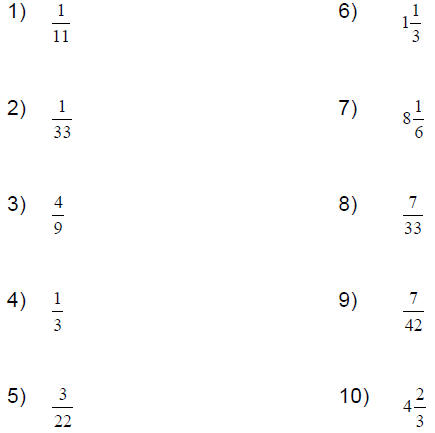
Converting Decimals to Fractions
| To convert a terminating decimal to a
fraction, write the decimal with the place value multiple of ten as a denominator and reduce to simplest terms. |
|
| Example:
|
The decimal fraction portion of the number
terminates in the tenths place; therefore the denominator will be 10. This fraction is not in lowest terms , therefore must be reduced. Divide numerator and denominator by 2. |
| To convert a repeating decimal to a
fraction, use a value of 9 as the denominator. |
|
| Example:
|
The repeating pattern ends in the hundredths
place, therefore the denominator will have two nines, or be 99. This fraction is not in lowest terms, therefore must be reduced. Divide numerator and denominator by 9 |
Convert:
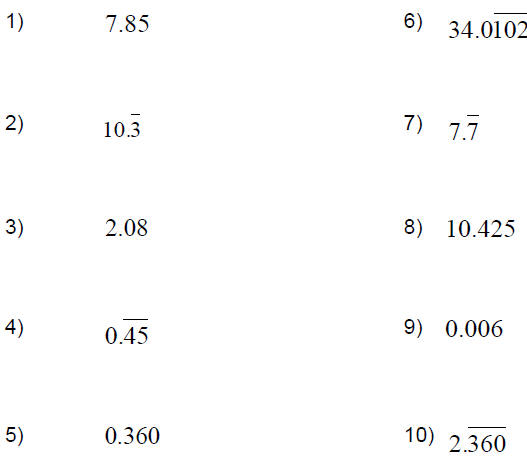
Word Problems
| To solve a word problem, read the
problem and express what you are trying to learn in your own words. Identify the operation to be used, (addition, subtraction, multiplication, or division). Translate the problem from words to math symbols , (i.e. write an equation). Solve the equation. |
|
| Example: Carlos bought one pair of shoes for $19.95, two neckties for $3.95 each, three pairs of socks for $1.25 a pair, and one suit for $89.95. What was the total cost? |
|
| Trying to learn total cost of the items.
|
Total cost usually implies addition. One pair of shoes 3.95 x 2 Two neckties 1.25 x 3 Three pair of socks One suit Add with decimal points lined up. |
| Example: Nora made 18 equal monthly payments on her new stereo set. If the total cost of the set was $355.00, what was her monthly payment? (Round off to the nearest cent.) |
|
| Trying to learn Nora's monthly payment.
The monthly payment |
Total and number of months are given. Division is implied Total divided by number of months gives each month's payment. The answer must be to the nearest cent; that is rounded to the hundredths place. Divisor is a whole number. To continue the division, another zero may be added. However, the next digit in the quotient will be a 2 and by the rules of rounding, will not effect the current quotient. |
Solve the following.
1) The $146.35 cost of a party was shared by 10 people. How much did each
person have to pay? (Be sure to round your answer to the nearest cent.)
2) 537 people attended a $100 dollar a plate fund raising dinner for the NSCC
Foundation. How much money did this dinner raise?
3) At the beginning of the month, Jim's bank balance was $275.38. During the
month he wrote the following checks: $174.89, $68, and $57.76. He made
deposits of $250 and $350. Find his bank balance at the end of the month.
4) Rudy drove his car 9,600 miles last year. His total car
expenses were $625
for the year. Find the average cost per mile. (Round off your answer to the
nearest hundredth)
5) A garden is 33.75 feet long and 21.6 feet wide. Draw a
diagram of the
garden with the lengths written on all four sides. What is the total
distance around the garden?
6) A car traveled at 50 miles an hour for 2.5 hours. How far did it go?
7) A can of ham weighing 7.75 pounds costs $ 11.86. What does the ham
cost per pound? (Round to the nearest cent.)
8) A park is 4.6 miles long and 2.7 miles wide.
a. What is the total distance around the park?
b. If a racecar drove 50 times around the park, how far will it have to
go?
Answers to Exercises
| Page 8 | Page 9 | Page 13 | ||
| 1. Twenty and fifteen hundredths |
1 | 4.5 | 1 | 62.9 |
| 2 | 0.14 | |||
| 3 | 0.1972 | 2 | 14 | |
| 2. Forty-five and twenty-one hundredths |
4 | 407.328 | 3 | 3.5691 |
| 5 | 0.1 | 4 | 3.1 | |
| 6 | 7.09 | 5 | 500 | |
| 3. Fifteen and one hundred ninety-six thousandths |
7 | 0.0172 | 6 | 19.8 |
| 8 | 22.5 | 7 | 0.007 | |
| 4. Two thousand, forty-nine and nine thousandths |
9 | 20.496 | 8 | 390 |
| 10 | 300.03 | 9 | 34 | |
| 5. Eight thousandths | Page 10 | 10 | 50.00 | |
| 1 | 72.19 | 11 | 5.007 | |
| 2 | 301.007 | 12 | 0.674 | |
| 6. Four and five hundredths | 3 | 0.17 | 13 | 2.0 |
| 4 | 1276.3 | 14 | 0.0170 | |
| 7. Two hundred seventy-eight and fifty-four hundredths |
5 | 1.06 | 15 | 0.01 |
| 6 | 0.024 | 16 | 0.001 | |
| 8. Seven and seven ten-thousandths | 1 | 0.1234, 1.234, 12.34 |
Page 14 | |
| 1 | 0.43 | |||
| 2 | 0.333 | |||
| 2 | 0.01, 0.1, 1.001 |
3 | 63.831 | |
| 4 | $18.01 | |||
| 3 | 0.031, 0.331, 3.1 |
5 | 9.1712 | |
| 9. One and one tenth | 4 | 0.06, 0.4, 0.9 | 6 | 48.84 |
| 5 | 0.56, 0.6, 0.935, 1.2 |
7 | 31.811 | |
| 6 | 0.054, 0.12, 0.16, 0.2, 0.48 |
8 | $10.08 | |
| 10.One thousand nine hundred twenty-eight and seven hundredths |
7 | 0.5382, 5.038, 5.0382, 50.382 |
9 | 2442.679 |
| 8 | 0.08, 0.088, 0.8, 8.08, 8.808, 8.888 |
10 | 60.8381 | |
| Page 15 | Page 18 | Page 21 |
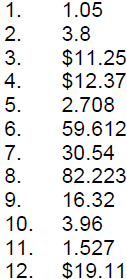 |
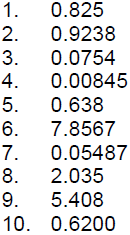 |
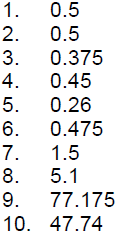 |
| Page 16 | Page 19 | Page 22 |
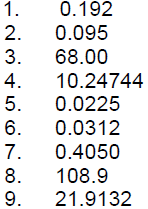 |
 |
 |
| Page 17 | Page 20 | |
 |
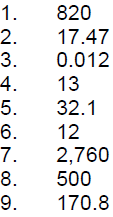 |
Page 23

Page 25-26
1. $14.64
2. $53,700
3. $574.73
4. $0.07 per mile
5. 110.7 feet
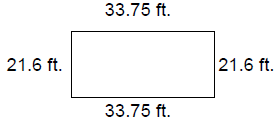
6. 125 miles
7. $1.53 per pound
8.
a. 14.6 miles
b. 730.0 miles
Place Value Chart
| Hundred Million | Ten Millions | Millions, | Hundred Thousands | Ten Thousands | Thousands, | Hundreds | Tens | Units (Ones) | Decimal Point (and) | Tenths | Hundredths | Thousandths | Ten-Thousandths | Hundred-Thousandths | Millionths | Ten Millionths | Hundred Millionths |
| • | |||||||||||||||||
| • | |||||||||||||||||
| • | |||||||||||||||||
| • | |||||||||||||||||
| • | |||||||||||||||||
| • | |||||||||||||||||
| • | |||||||||||||||||
| • |
| Prev | Next |






